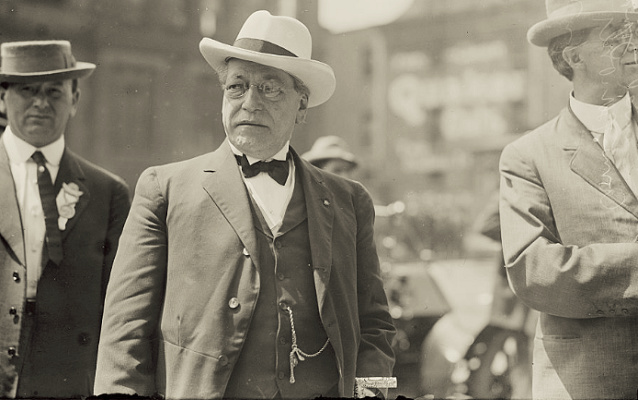Last updated: August 1, 2020
Place
Samuel Gompers House

Labor leader and founder of the American Federation of Labor (AFL), Samuel Gompers lived and worked in this house in DC’s Bloomingdale neighborhood. The modest brick rowhouse served not only as his residence, but also as a forum for labor organizing and political debate. A former cigar maker, Gompers was president of the AFL for 37 years during which time he transformed labor conditions of workers across the nation.
Born into a working-class Jewish family in London tenement housing in 1850, Gompers and his family immigrated to New York City during the Civil War. Long before he rose to prominence as a spokesperson for organized labor, his father, Solomon, taught him the cigar-making trade. In 1864, Samuel joined the Cigar Makers Local Union No. 15. At age 17, he left his father to work in a New York City cigar factory. Around this time, he met and married Sophia Julian. They would remain married until her death in 1920.
Although he had little formal education, Gompers’ learned through experience as he established himself at the factory. It was the custom at that time for one of the workers to read aloud to the others as they labored. All manner of social, economic, and political commentary was read and discussed, and it was here that Gompers was first awakened to the critical works of European intellectuals like Karl Marx, Friedrich Engels, and Ferdinand Lassalle.
In 1875, Gompers became president of the Local 144 of the Cigar Makers International Union in New York City. Under his direction, the union professionalized by establishing a leadership hierarchy and creating an operating fund. It also adopted, or prepared to adopt, sickness, accident, and unemployment benefits.
Gompers became known for his poignant speeches and passionate appeals. He championed collective bargaining and contracts. His revitalization of the union prompted workers in other trades to model their labor organizations after the Cigar Makers International Union.
In 1877, Gompers and other union workers organized the Federation of Organized Trades and Labor Unions of the United States of America and Canada, which became the AFL in 1886. This federation, comprised of various trade unions, collectively advocated for their rights. Gompers was elected president of the new organization, and served in that position (with the exception of the year 1895) until his death in 1924. Gompers succeeded in making the AFL the strongest voice for organized labor in the United States.
The AFL moved its headquarters from Indianapolis to Washington, D.C. in 1897 in order to give more direct attention to legislative affairs affecting the union. Gompers and his family lived in the three-story row-house on First Street, NW for 15 years (1902-1917). His house became a discussion center on labor issues and how to solve them.
By 1919 Samuel Gompers was at the height of his power and fame, and president of the largest trade union organization in the world. During World War I, AFL membership skyrocketed from two million to four million members. On behalf of President Woodrow Wilson, Gompers, as part of the Commission on International Labor Legislation, participated in the peace negotiations in Europe. This led him to international fame.
Gompers’ health began to decline just as he reached the pinnacle of power. He suffered increasingly from kidney problems, and in April 1919 lost his eyesight. He could no longer work without assistance and only lived five years longer. Samuel Gompers died in 1924 at the age of 74, after attending a meeting of the Pan-American Federation of Labor in Mexico City. He is buried in Sleepy Hollow, New York.
Gompers worked tirelessly throughout his life in to increase the laborer's share of the profits of industrialism. As AFL president, Gompers believed there was only one direction toward which labor could unite: more wages, shorter hours, better working conditions. He directed all of his energies toward a realization of these goals for American workers. The house on First Street NW, which became a National Historic Landmark in 1974, still stands to commemorate him.
Sources:
"Samuel Gompers." AFL-CIO.
“Samuel Gompers.” Jewish Virtual Library.
“Samuel Gompers, Labor’s Grand Old Man.” Newspaper & Current Periodical Reading Room. The Library of Congress.
“The Samuel Gompers Papers.” The University of Maryland.
National Historic Landmark Nomination of the Samuel Gompers House.
National Historic Landmarks (NHLs) are historic places that possess exceptional value in commemorating or illustrating the history of the United States. The National Park Service’s National Historic Landmarks Program oversees the designation of such sites. There are just over 2,500 National Historic Landmarks. All NHLs are also listed in the National Register of Historic Places.
